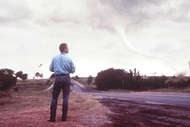Create a free profile to get unlimited access to exclusive videos, sweepstakes, and more!
A mysterious sea creature makes its debut on U.S. shores

Last week, a mysterious creature washed ashore at the UC Santa Barbara's Coal Oil Point Reserve in Southern California. It resembled a large sunfish, roughly six feet from end-to-end, but with its lack of tail and fused teeth, it baffled researchers.
As CNN reports, how its true identity was found proved just as interesting.
It started when conservation specialist Jessica Nielsen was alerted to the fish on February 19th, who described it as "the most remarkable organism I have seen wash up on the beach in my four years at the reserve." Nielsen posted photos to the reserve's Facebook page, which prompted her colleague Thomas Turner to take some photos of the fish, which he also posted to the research site iNaturalist.
It was eventually revealed that creature in question is what's known as a hoodwinker sunfish. The species was first discovered by Marianne Nyegaard back in 2017, who noticed the fish when the researchers at Coal Oil Point posted pictures to social media.
However, her research indicated that the hoodwinker stuck to Australia, New Zealand, South Africa, and Chile -- and one isolated period in the 1980s when it was spotted in the Netherlands.
"This is why it's so intriguing why it has turned up in California," Nyegaard explained. "We know it has the temperate distribution around here and off the coast of Chile, but then how did it cross the equator and turn up by you guys? It's intriguing what made this fish cross the equator."
No one's sure if this is the same classification of hoodwinker sunfish that Nyegaard has studied before, even though they have a tendency to wander. She plans on obtaining a genetic sample from the creature, so as to better determine if this is a long-wandering stray or if a new species has been 'hoodwinking' scientists off the west coast this whole time.


























